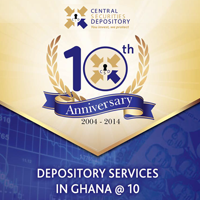The first tranche of GH¢6 billion of the GH¢10 billion energy bond, which saw bids open yesterday, is expected to deepen the local corporate bond market.
With a total of GH¢36.64billion corporate and government bonds and notes listed on the Ghana Stock Exchange (GSE), only GH¢570.55million – representing 1.56 percent – are corporate bonds, which market operators believe is not enough.
Sam Aidoo, Director of Treasury & Market at Fidelity Bank – co-manager of the bond, noted that the energy bond will deepen activity on the debt market and add to a growing list of corporate bonds.
“If you look at the corporate bonds listed on the exchange, less than 1 percent of all listed fixed income instruments are corporate bonds. This bond gives us the opportunity to further deepen the corporate bond market,” he told journalists at a briefing after the local roadshow came off in Accra on Monday.
Xorse Godzi, Country Head of Global Banking at Standard Chartered Bank – co-manager of the bond, added that the bond will improve liquidity on the market, aside from reducing NPLs which have been a major problem in the banking sector, among others.
“This is an issuance that has never happened in this country before. This is well-structured and all the market participants see it as a well-structured transaction, and so it will further deepen the debt capital market in the country,” he added.
Over 200 local investors, including pension funds, gathered at Alisa Hotel, Accra, and were briefed on the nature and structure of the bond, which has been described as a better alternative to raising capital to clear the energy sector debt.
The first part of the local currency denominated bond, to be issued in two tranches of GH¢2.4billion and GH¢3.6billion, will have seven-year and 10-year tenures respectively, and will be listed and traded on the Fixed Income Market of the Ghana Stock Exchange (GSE) under conditions yet to be announced.
With an average of GH¢110 to GH¢120million a month accruing in the Energy Sector Levy Act (ESLA) account, Mr. Aidoo noted that the structure of the bond is a semi-unsecure instrument and backed by the ESLA flows, which is an Act of Parliament that came into being in December 2015.
Yields to come in at 19 percent
Analysts are predicting the yield on the bond – which has generated a lot of interest from both foreign and domestic investors – to come in at 19 percent, with reference to other government issuances this year which have seen 5 to 15-year instruments attracting between 18-20 percent.
First National Bank, in its daily market update, expects the yield to come in at 19 percent. “We believe the yield could come in at around 19 percent,” it said, adding that the bond will be attractive to investors due to “Ghana’s economic recovery and political stability – and especially as offshores hunt for duration on cedi debt”.
Assurance for foreign investors
The lead managers assured that, just like other government bonds issued this year and listed on the local bourse, the energy bond can easily be accessed by foreign investors who already hold about 50 percent of government securities.
“If you look at government issuances till today, it is around upward of GH¢45billion including bills all the way to 15-year instruments. Close to 50 percent of that is held by offshore investors, and those offshore investors are comfortable with holding and trading it.
“I believe this will follow the same sort of process as the government of Ghana securities: it is listed on the GSE and issued by a calculating agency, Central Securities Depository (CSD); and just as with government of Ghana securities, offshore investors hold up to GH¢22billion and are already comfortable trading-in,” Mr. Aidoo said.
Source: B&FT Online


